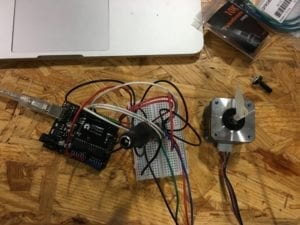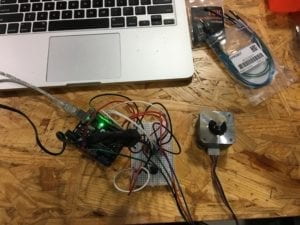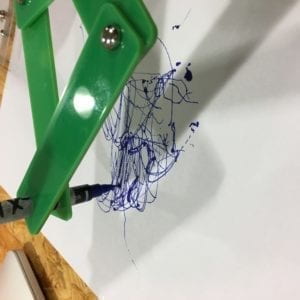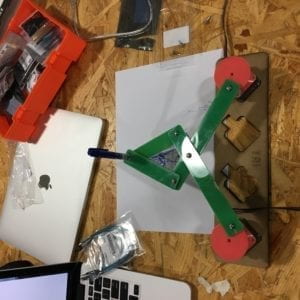Lab Date: Mar. 15 2019
Instructor: Marcela
Lab Partner: Jackson
Aim of Today’s Lab: Build a drawing machine with a partner after building a motor with your Arduino kit
Building the circuit
Materials used: Arduino kit and its contents, Power Jack, N754410NE ic chip, 42STH33-0404AC stepper motor, 12 VDC power supply
Process:
For this circuit, I was pretty hesitant about the process. I used a computer from the Equipment Room. Following the schematic, I built the circuit and double checked if my connections were correct. I had to change my stepper motor because the loose connections of the wiring. After uploading the file to my Arduino and plugging my Arduino into the 12 VDC power supply, my circuit buzzed, but it did not rotate. After asking, I learned it was because my H-Bridge (ic chip) was not connected all the way. Once pushing it into my breadboard, it worked.

Adding the potentiometer to control rotation
Process:
Once the circuit was completed, I proceeded to add the potentiometer which I had no problem to do so. I uploaded the code with the map function which worked without any problems.

Building the drawing machine
Materials used: 2 Laser-cut short arms, 2 Laser-cut long arms, 1 Laser-cut motor holder, 2 3D printed motor coupling, 5 Paper Fasteners, 1 Pen, Paper, Circuit from the previous step
Process:
I teamed up with Jackson to build the drawing machine. We collected the materials and built our drawing machine according to the picture.


Conclusion
Overall, I think it was cool making this drawing machine because we get to see the Arduino in the works outside of its hardware. Pretty inspiring!
One thing I learned is to make sure to put all the components securely in place and double check your wiring on circuits that use high voltage.
Answers to the Questions
What kind of machines would you be interested in building? Add a reflection about the use of actuators, the digital manipulation of art, and the creative process to your blog post.
A machine I would be interested in building would be building a drone that can morph itself, so it can fly, swim, dive, walk, etc. and if possible, will change size so it can move through crammed places and sustain through rough environments. The actuators it would use would probably be within the drone itself. The changes in size would be the tricky party. Visually, I think it would be interesting for it to camouflage within its environment. The creative process would most likely involve plenty of prototypes and sketches in design. I think it’s default size would most likely be of a moderate size like a bird. Technically, it would be definitely difficult and way outside my skill level (or even technology at the moment right now). The drone would be controlled by a controller.
Choose an art installation mentioned in the reading ART + Science NOW, Stephen Wilson (Kinetics chapter). Post your thoughts about it and make a comparison with the work you did during this recitation. How do you think that the artist selected those specific actuators for his project?
Time’s Up, Gravitron.
Compared to work I did in this recitation, this art installation also had controllable components like we did in this activity. With the drawing machine, you could control the direction the drawing arms moved with the potentiometer. In this art installation, you can bend the gravity map by shifting your balance and moving around platforms. The artist used actuators by probably moving the platform in sync with the user’s motions.